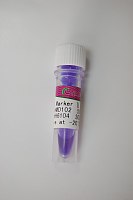Biochemical Techniques for the Characterization of G-Quadruplex Structures: EMSA, DMS Footprinting, and DNA Polymerase Stop Assay
互联网
835
The proximal promoter region of many human growth-related genes contains a polypurine/polypyrimidine tract that serves as multiple binding sites for Sp1 or other transcription factors. These tracts often contain a guanine-rich sequence consisting of four runs of three or more contiguous guanines separated by one or more bases, corresponding to a general motif known for the formation of an intramolecular G-quadruplex. Recent results provide strong evidence that specific G-quadruplex structures form naturally within these polypurine/polypyrimidine tracts in many human promoter regions, raising the possibility that the transcriptional control of these genes can be modulated by G-quadruplex-interactive agents. In this chapter, we describe three general biochemical methodologies, electrophoretic mobility shift assay (EMSA), dimethylsulfate (DMS) footprinting, and the DNA polymerase stop assay, which can be useful for initial characterization of G-quadruplex structures formed by G-rich sequences.









